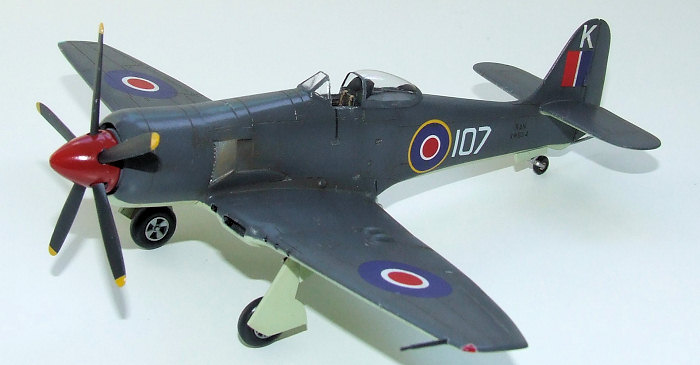
Special Hobby 1/72 Hawker Sea Fury
| KIT: | Special Hobby 1/72 Hawker Sea Fury |
| KIT #: | 72121 |
| PRICE: | AUD $21.00 |
| DECALS: | Two options |
| REVIEWER: | Peter Hobbins |
| NOTES: | Twin-seat T.61 ‘Baghdad Trainer Fury’ kit contains all parts necessary to make a single-seat FB.11 (except decals) |

| HISTORY |
The Royal Navy struggled all through World War II to obtain a
decent British carrier fighter. Starting with the poorly thought-out Blackburn
Skua and the mediocre Fairey Fulmar, the RN only gained an effective combat
aircraft once deliveries of the US-supplied Grumman Wildcat/Martlet commenced.
Later in the war the Grumman Hellcat and Chance-Vought Corsair performed
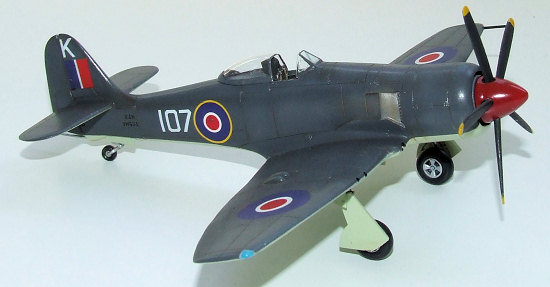 admirably, but the only British type with decent combat performance – the
various marks of Supermarine Seafire – had poor visibility and were generally
too fragile for sustained carrier operations. Hawker had adapted its Hurricane
to fly off carriers by 1941, but while robust, these aircraft lacked folding
wings.
admirably, but the only British type with decent combat performance – the
various marks of Supermarine Seafire – had poor visibility and were generally
too fragile for sustained carrier operations. Hawker had adapted its Hurricane
to fly off carriers by 1941, but while robust, these aircraft lacked folding
wings.
However, by 1944 Sydney Camm had developed his Fury ‘light fighter’ from the Tempest and a naval version was proposed. Engined with the superb but scandalously neglected Bristol Centaurus, the Sea Fury prototype first flew in February 1945 but by the time it entered service the war was over. Nevertheless, the type had excellent flight and fighting characteristics, and it went on to serve with the RN until the late 1950s. Sea Furies also flew with the Royal Australian and Canadian Navies, with the Dutch Navy and – in non-carrier deployments – with the air forces of Pakistan and Iraq. Germany, Egypt, Burma and Cuba also operated new-build or second-hand machines, the latter fighting over the abortive Bay of Pigs operation. Nevertheless, it was in Korea that the Sea Fury was first blooded, with both the RN and RAN operating the type in strike missions and famously ‘bagging’ a MiG-15 on 9 August 1952. The type lingered on in target-towing and training roles into the 1970s, and has enjoyed a healthy career as a warbird and racer, especially following the recovery of 26 airframes from Iraq in the 1970s. Interestingly, several more Sea Fury airframes have recently been ‘commandeered’ from Iraqi airfields during Operation Enduring Freedom.
| THE KIT |
There are now five injection-moulded kits of the Sea Fury in 1:72 that I am aware of. In order of appearance they are Frog/Novo, PM, High Planes, Special Hobby and Trumpeter. There is also the outstanding Aki resin kit with working flaps and incredibly detailed engine and gun bays, but that is another story (and price range!). I have built the Frog, High Planes and now the Special Hobby kits, and that will do me for now, thank you very much!
Most modellers are now likely to go for the Trumpeter kit,
which appears to be rather nice. However, the Special Hobby kit should not be
overlooked, especially if it’s going cheap. Indeed, of their two boxings of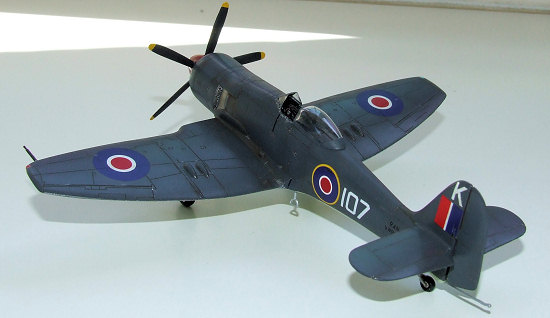 the Sea Fury, I would suggest that this is the better buy. Why? Because it
contains all of the pieces to build a single-seat fighter, plus a spare fuselage
and twin-place resin cockpit for the two-seater version. This means that, in
effect, you get three resin cockpits for the price of one. The downside is that
unless you want to build an Iraqi or Pakistani aircraft you’ll need another
source of decals, but as you’ll read, that didn’t start out being a problem for
me.
the Sea Fury, I would suggest that this is the better buy. Why? Because it
contains all of the pieces to build a single-seat fighter, plus a spare fuselage
and twin-place resin cockpit for the two-seater version. This means that, in
effect, you get three resin cockpits for the price of one. The downside is that
unless you want to build an Iraqi or Pakistani aircraft you’ll need another
source of decals, but as you’ll read, that didn’t start out being a problem for
me.
This boxing therefore contains 45 injection-moulded pieces (including two types of tailplanes, two rudder shapes and two sets of fuselages), in Special Hobby’s typical dark grey plastic. The surface finish is pretty nice but as usual their panel lines are neither as consistent nor as fine as those on the High Planes kit, for instance. The sprues contain the Sea Fury’s distinctive drop tanks but no other underwing stores. There are also 15 resin pieces (including the single-seater and twin-seat cockpit layouts), a photoetch fret containing two instrument panels and harnesses, plus instrument panel backing on film and a single-piece vacform canopy of the unique ‘double bubble’ export style. The kit also includes an 8-page A5-size instruction booklet – featuring a parts layout and painting guide – and a nice-looking decal sheet for an Iraqi trainer circa 1953 and a Pakistani machine from 1954. I didn’t use the decals so I can’t comment on how they perform either in water or with setting solution.
| CONSTRUCTION |
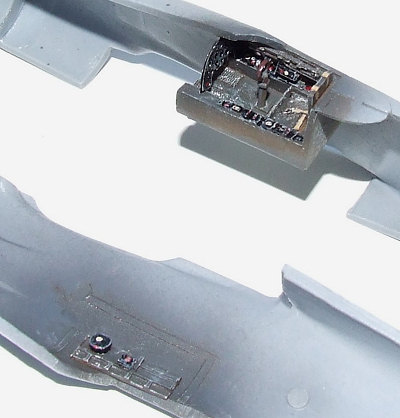 As with most single-seat fighters the construction of this
kit was relatively straightforward so I won’t connect the leg bone to the hip
bone, etc. It was nice to see that Special Hobby are now incorporating tabs for
inserting their tailplanes, and alignment aids in the fuselage to help situate
the cockpit tub correctly. In fact, very little filler was required and there
were only two areas where I encountered any problems.
As with most single-seat fighters the construction of this
kit was relatively straightforward so I won’t connect the leg bone to the hip
bone, etc. It was nice to see that Special Hobby are now incorporating tabs for
inserting their tailplanes, and alignment aids in the fuselage to help situate
the cockpit tub correctly. In fact, very little filler was required and there
were only two areas where I encountered any problems.
Firstly, the rudder is incorrect for all versions – instead
of meeting the vertical fin in a straight line, there should be a prominent
hinge block half-way down. This is correctly represented in all other Sea Fury
Kits, so I’m surprised that Special Hobby made such a basic mistake. Anyways, to
rectify the problem the relevant area on the fin has to be cut or filed out
square (follow the kit’s panel lines), and a new block of plastic has to be
attached to the fin and  sanded to match. No real drama, but an unnecessary niggle.
sanded to match. No real drama, but an unnecessary niggle.
The only other hassle during construction is associated with the resin wheel well insert. Although it’s nicely detailed and appropriately deep, this insert should meet squarely with the edges of the undercarriage bay cutout in the lower wing, which makes for a very tricky filling job to hide the gap. Apart from this, my only other quibbles are the absence of retraction arms for the main undercarriage legs and the anaemic-looking propeller blades (I decided to live with them). I also drilled out the exhaust stubs on the fuselage sides and cut the kit’s double canopy into three pieces, giving me the equivalent of a single-seater canopy and a rather useless spare bit from the middle.
| COLORS & MARKINGS |
I mainly build Australian-operated aircraft, so the absence
of British decals in this boxing didn’t bother me particularly. While alm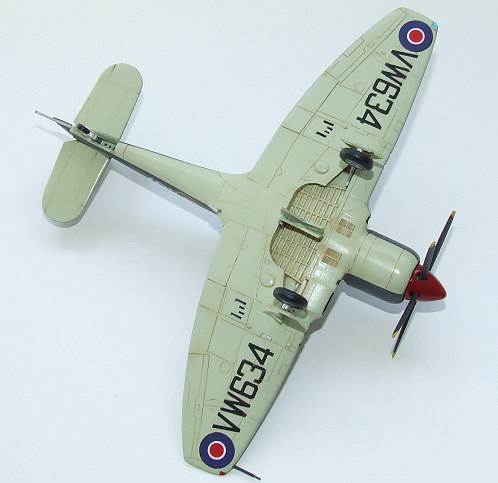 ost all
RAN Sea Furies operated with the sky lower surfaces meeting extra dark sea grey
uppers high on the fuselage, I managed to find two shots of an RAN aircraft with
the earlier low demarcation line. I could pick out the white ‘K’ on the tail for HMAS Sydney, but not enough detail to determine the serial number or
whether this was actually a RAN machine or a RN aircraft deployed to the
Sydney for the carrier’s shake-down cruise in 1949. I chose to go with the
former, but I have to confess that despite my best research, I can’t prove that
this particular RAN serial matches the specific scheme and ‘107’ fuselage
marking that I modelled.
ost all
RAN Sea Furies operated with the sky lower surfaces meeting extra dark sea grey
uppers high on the fuselage, I managed to find two shots of an RAN aircraft with
the earlier low demarcation line. I could pick out the white ‘K’ on the tail for HMAS Sydney, but not enough detail to determine the serial number or
whether this was actually a RAN machine or a RN aircraft deployed to the
Sydney for the carrier’s shake-down cruise in 1949. I chose to go with the
former, but I have to confess that despite my best research, I can’t prove that
this particular RAN serial matches the specific scheme and ‘107’ fuselage
marking that I modelled.
My first step was to spray the metallic panels on the fuselage side first with Tamiya gloss black and then Alclad duralumin. After masking this area off, painting with Gunze colours was straightforward, although after completion I felt that their extra dark sea grey is way too ‘extra dark’ compared with the real thing, especially under a few coats of Future. I did, however, enjoy painting a glossy red spinner, as this clearly showed up in colour photos. The decals were raided from the High Planes Sea Fury kit; while they are normally first-rate, these shattered on contact with water, leaving me to raid a Ventura Seafire 47 kit for most of the serials, filling the gaps from the spares box and my own less than perfect home-printed codes. After sealing the decals with Future, a light wash of thinned raw umber oil paint was oversprayed with a coat of Gunze flat, which leaves a somewhat satin sheen appropriate for post-WWII aircraft.
| CONCLUSIONS |
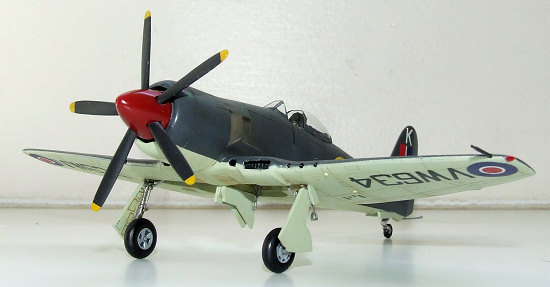 All in all this is a straightforward build; the small matter
of the rudder block was a simple enough fix. The only things that marred the
finished model were unrelated to the kit, namely the shade of grey I used for
the upper surfaces and the uncharacteristically problematic High Planes decals.
The finished product matches up pretty well with published plans. Although the
fine detail on pieces such as the undercarriage legs is probably a shade cruder
than Trumpeter’s offering, the resin cockpit is really rather nice so don’t pass
up this model just because it’s in the ‘limited run’ section of your hobby shop.
And if you’re a cheapskate like me, you can buy this boxing and end up with two
spare cockpits (both of which I’ve already used … stay tuned!).
All in all this is a straightforward build; the small matter
of the rudder block was a simple enough fix. The only things that marred the
finished model were unrelated to the kit, namely the shade of grey I used for
the upper surfaces and the uncharacteristically problematic High Planes decals.
The finished product matches up pretty well with published plans. Although the
fine detail on pieces such as the undercarriage legs is probably a shade cruder
than Trumpeter’s offering, the resin cockpit is really rather nice so don’t pass
up this model just because it’s in the ‘limited run’ section of your hobby shop.
And if you’re a cheapskate like me, you can buy this boxing and end up with two
spare cockpits (both of which I’ve already used … stay tuned!).
| REFERENCES |
Stewart Wilson. Sea Fury, Firefly and Sea Venom in Australian Service. Weston Creek: Aerospace Publications, 1993.
Australian National Naval Aviation Museum. Flying Stations: a Story of Australian Naval Aviation. St Leonards: Allen & Unwin, 1998.
November 2007
If you would like your product reviewed fairly and quickly, please contact me or see other details in the Note to Contributors.